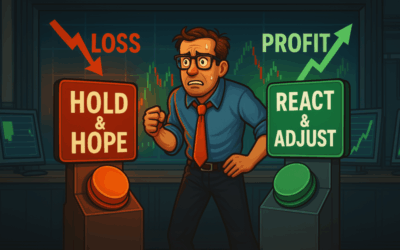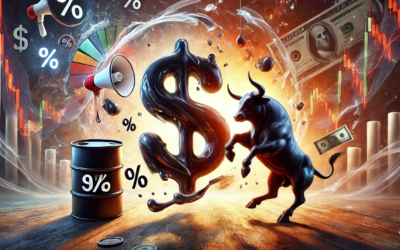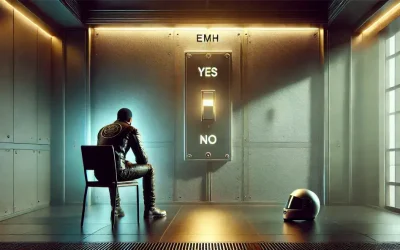6 Misconceptions That Blind Traders —And How to Overcome Them
If you’ve been trading for a while, you’ve probably felt stuck. Spinning your wheels, trying harder, and not getting anywhere is frustrating, right? Maybe you’ve convinced yourself that the solution is more knowledge, more tools, or uncovering some “secret” that only the pros know.
Here’s the truth: none of that will get you where you want to go.
The problem isn’t that you don’t know enough or aren’t trying hard enough. It’s likely to be one or more of these misconceptions – things traders believe that sound logical but hold them back. They point you in the wrong direction, like trying to ride a motorcycle with a blindfold on.
Let’s explore six of the biggest misconceptions that trip traders up—and how you can overcome them.
1. More knowledge leads to better trading.
This one is everywhere. It’s not taught by anyone – it’s just an understandable assumption almost all traders make. After all – knowledge is power, right?
The idea is that the more you know, the better you’ll trade. So you go from video to video, book to book, soaking up everything you can. Maybe you even feel like you’re making progress.
But are you? Or are you just adding to the noise in your head?
The Reality: Trading isn’t about how much you know. It’s about what you can do. It’s a skill game, not a knowledge game. All the knowledge in the world won’t help if you can’t identify a simple opportunity and keep your head straight while executing.
The Fix:
- Focus on building repeatable skills, not accumulating random facts. Pick one market event or setup—just one—and get good at it. You can add more later.
- Stop chasing theory and start practicing. Knowledge without action won’t get you anywhere.
The Free Trading Manifesto shows you how to focus on what matters, cutting through the noise and turning knowledge into execution. And tools like Jigsaw’s Journalytix help you track your progress, ensuring you improve with every trade.
2. Markets are unpredictable, so trading success is based on luck or gut feelings.
If you’ve ever felt like trading is a guessing game, you’re not alone. Many traders rely on gut instincts or try to outguess the market, treating it like gambling.
The Reality: While market movements are complex, they often respond predictably to major events and setups. The problem isn’t that markets are unpredictable—it’s that many traders don’t know what to look for. On an individual trade basis, the result of your next trade IS random – but it’s over a series of trades that the predictability comes into play.
The Fix:
- Track how markets react to recurring events.
- Earnings reports or economic data.
- Signs of momentum for continuation trades.
- “Big Boy” Levels like the 200/50 daily MA, yesterdays high/low, yesterdays close
- For reversal trades – focus on events that visibly shift the volume and cumulative delta.
- Base your decisions on observable patterns, not feelings or guesses.
The Free Trading Manifesto gives you a clear framework for identifying predictable market reactions, while Jigsaw’s order flow tools help you see how traders react in real time.
3. Using more tools and indicators makes trading easier.
Ah, the tool junkie’s dilemma. You think that if you just find the right combination of tools, indicators and settings – everything will click. Maybe you’ve loaded up your charts with half a dozen indicators or tried every new gadget that promises to revolutionize your trading.
Doesn’t seem to help, does it?
The Reality: More tools don’t mean more clarity. They mean more distractions. You end up second-guessing yourself, chasing conflicting signals, and missing the forest for the trees. From a practical viewpoint – it’s a lot easier to make consistent decisions based on 10 data points than 100 data points.
The Fix:
- Simplify your approach. You don’t need a hundred tools to trade successfully. In fact, you’ll do better with fewer tools and more specialization. Jack of all trades or master of one?
- Use the standard settings on all tools.
- Keep essentials like order flow analysis for confirmation and price refinement – tools that help you see what’s really driving the market and that CLEARLY show when others are coming into the market en-masse to ensure you can exploit the move.
The Free Trading Manifesto identifies the essential tools for success, while Jigsaw’s platform makes it easy to apply them with precision. With fewer distractions, you can finally trade with clarity.
4. Old strategies are outdated because markets constantly evolve.
This one sounds logical. Markets evolve, so your strategies should too, right? But this misconception leads traders to constantly tinker with their approach, never sticking with anything long enough to get good at it.
The Reality: While markets do change, the fundamentals of trading success don’t. Traders react to supply, demand, and key events – these things have driven markets forever and always will.
The Fix:
- Focus on adapting execution to current conditions without abandoning proven principles. Basically, it’s the same market with the same underlying asset – but the volatility shifts up and down over time.
- Recognize that volatility changes, but the core drivers of market movement stay the same.
The Free Trading Manifesto teaches you how to adapt your strategies without losing sight of the fundamentals, and Jigsaw’s tools help you monitor those changes with real-time precision.
5. I can learn to trade by trial and error alone.
Trading can feel like a DIY project. You think you’ll figure it out by trying things until something works. After all, isn’t that how everyone learns?
The Reality: Trial and error without structure just means repeating mistakes. You waste time, money, and energy going in circles without ever building real skills.
The Fix:
- Create a structured learning plan. Focus on one skill at a time and track your progress.
- Seek guidance or resources that give you a roadmap to follow.
The Free Trading Manifesto is that roadmap, helping you avoid costly mistakes, while Jigsaw’s Journalytix tracks your progress and ensures you’re improving systematically.
6. Professional traders have secret strategies that aren’t accessible to me.
This is the myth that keeps traders chasing their tails. You tell yourself that the pros have some kind of magic formula, some secret sauce that isn’t available to the rest of us. So you keep looking, hoping to find it.
But here’s the thing: there are no secrets.
The Reality: Professional traders don’t win because they have special strategies. They win because they’ve mastered the basics and developed their skills through repetition. The market doesn’t move on secrets – it moves on big, obvious things that everyone can see.
The Fix:
- Stop chasing invisible edges and focus on visible patterns. If it’s not moving the market, it doesn’t matter.
- Learn to react to what’s in front of you, not what you think might be happening behind the scenes.
The Free Trading Manifesto breaks this down for you, while Jigsaw’s order flow tools let you see exactly how traders react to those big, obvious events.
Conclusion
If any of these misconceptions sound familiar, it’s because they’re common traps that almost every trader falls into. But they don’t have to keep you stuck.
The Free Trading Manifesto is your guide to removing the trading blindfold, focusing on what truly matters, and navigating your trading journey with clarity and confidence. It’s not about overwhelming you with knowledge; it’s about helping you master the skills and tools that lead to results.
Ready to see clearly? Get The Free Trading Manifesto today and start building a trading journey that stays on track.
What’s been your biggest misconception about trading? Let me know in the comments or on social media—I’d love to hear from you.
FREE BONUS: Take a look into the decision-making process of professional traders with this video training series that helps you make smarter trading decisions.




0 Comments